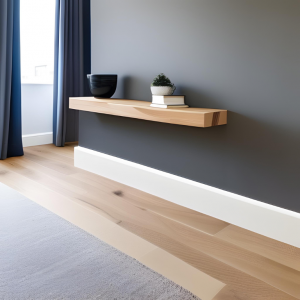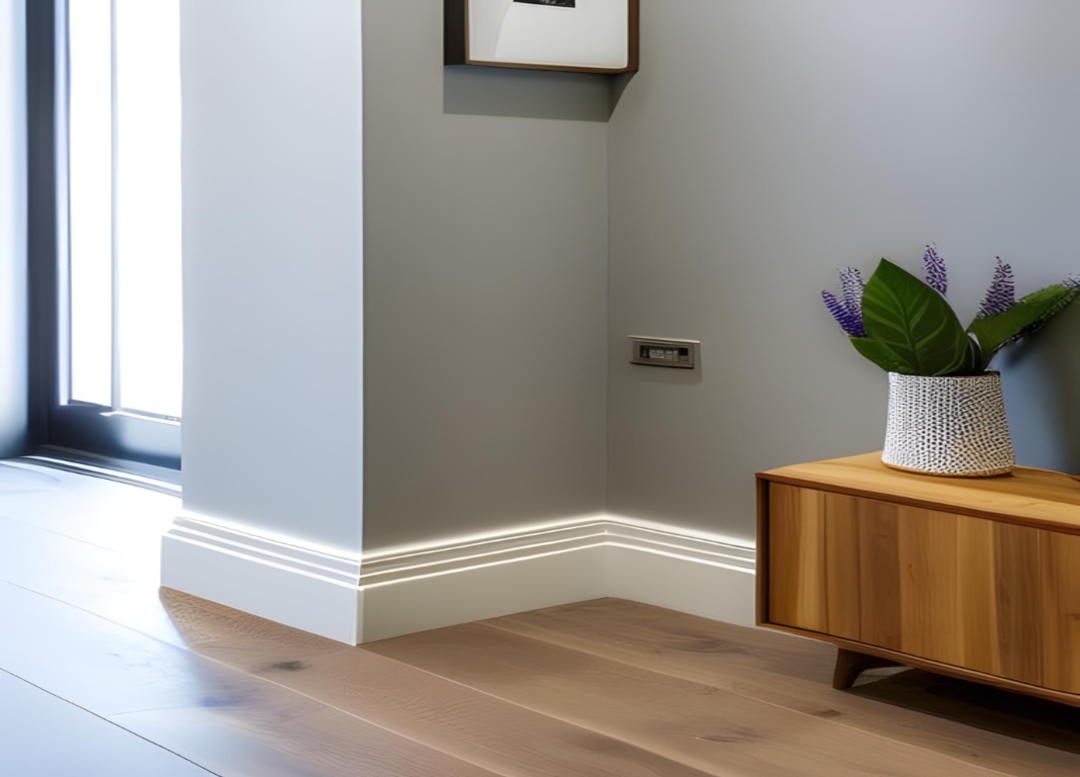What is the trend for skirting boards?
Skirting boards serve a functional purpose of protecting walls from damage caused by daily wear and tear. Homeowners are increasingly recognizing their importance and incorporating them into their homes.
Skirting boards can also enhance the aesthetic appeal of a space by using various materials, colors, and finishes.

Some on-trend styles include MDF material due to its durability and ease of preparation, bold or pastel colors, and monochromatic finishes. Skirting board profiles, such as Georgian, Ovolo, Bullnose, Square, and Chamfer, can also add a unique touch to a room.
By upgrading skirting boards, homeowners can express their personality, style, and habits through their living space.
Do modern houses have skirting boards?
Yes, modern houses typically have skirting boards, but they tend to be smaller in size compared to those found in more traditional or period homes. When choosing a skirting board for a modern interior, it’s important to consider its profile design.
Minimal designs with clean lines are often preferred, with grooved profiles being particularly trendy at the moment. The most popular modern skirting board is the Square Groove, which allows for a seamless transition from skirting board to architrave.

The size of a modern skirting board should be proportional to the size of the room and not too bold or overpowering.
As for color, white is a classic and popular choice for a minimalist look, while darker colors like grey are also becoming increasingly popular as accent pieces. Ultimately, the choice of skirting board for a modern interior will depend on personal style and preference.
What size is modern skirting?
The height of the skirting board you choose can depend on various factors such as the age of the property, the ceiling height, and the interior design theme. For instance, in older properties with grander rooms and higher ceilings, taller skirting boards are often used to create a balanced look.
The standard height for skirting boards is around 145mm, although there are options ranging from 70mm to 350mm. The profile size of the skirting board should also be considered, as some designs have a more detailed section than others.
If you prefer a taller skirting board, heights of around 220mm and above can make a bold statement in your space.

There are also exclusive designs available for those who want a grand style with a larger profiled section, starting from heights of 170mm. The interior design theme can also influence the height of your skirting board.
Minimalist interior design often favors small, subtle skirting boards, while maximalist design tends to prefer taller skirting boards painted in bold colors to match the overall grandness of the room.
In conclusion, choosing the right height for your skirting board depends on several factors such as the size of the room, the overall design theme, and personal preferences. Considering these factors will help you find the perfect skirting board to complement your home.
What are modern alternatives to skirting?

Skirting boards are a common feature in most homes, but if you want to opt for something different or need an alternative for a specific space such as a garden or mobile home, there are a few options available. Let’s take a look at some of the modern alternatives to skirting boards.
One alternative is a shadow gap, which removes the need for skirting boards altogether. Shadow gaps are small, recessed gaps at the bottom of a wall, and are popular in modern and minimalist settings. While shadow gaps are difficult to pull off and require meticulous craftsmanship, they can produce a sleek and modern look.
Shadow gap profiles can be purchased to aid in the creation of the line around the bottom of the room, which can also house LED lighting strips for an added effect.
Another alternative is using beading instead of skirting. Beading will bridge the gap between the floor and the wall like skirting, but in a much smaller form.
Beading is often used alongside skirting to add further detailing to the lower part of the wall or cover expansion gaps where the flooring has been installed up to the skirting rather than underneath it.

However, if you are considering using beading as a skirting board alternative, it is advisable to use a small skirting board instead, as beading would not provide sufficient protection against bumps and scrapes.
Tiling can also be used as a skirting board alternative in bathrooms and kitchens. Using the same tiles used on the floor as skirting can create a uniform appearance, and as most tiles used in bathrooms are waterproof, this can also provide a water-tight seal at floor level.
For mobile homes or commercial environments that require a more robust and durable option, metal and galvanized skirting can be considered.
Metal skirting is available in various finishes and can offer a modern high-tech aesthetic and streamlined look as they can be shaped around corners, rather than being cut.
Metal skirting is also easier to clean and extremely durable, making them ideal for sanitary environments and areas with high foot traffic.
What can you use instead of wood skirting?
One alternative to wood skirting is to replace it with wall panelling, such as wainscoting. Wall panelling can protect walls from damage and scuffs in a similar way to skirting boards, while also providing an opportunity to create shelving or conceal insulation and pipework services.

Wainscoting, in particular, is a type of wood panelling that can be fitted to the lower section of the wall and serves as a stylish and functional alternative to traditional skirting boards.
Should skirting match wall or floor?
When it comes to choosing skirting boards, a safe and popular rule to follow is to match them with the floor. This ensures that the shades and structures of both the floor and skirting complement each other well.
Opting for skirtings from the same producers as the floor is a good choice as it increases the chances of finding a perfect match.
Using skirtings that match the floor can make a room appear larger, especially if the floor is bright. Universal skirtings are another option that is cheaper and widely available in many shops. They come in a wide range of colors and can be easily selected in stores.

Matching skirting to the color of the wall is also gaining popularity. Blending skirting into the wall by choosing a color that is coherent with the wall creates a subtle effect.
Alternatively, creating a highly contrasting effect by combining different colors of skirting and wall can make the skirting look amazing.
White skirting with a dark wall or dark skirting with a white wall is a pleasing combination, but careful consideration and experience in installation is needed for this approach. Both options provide a modern look to the interior design.
Is it OK to not have skirting?
Skirting boards serve multiple purposes in a home. Firstly, they protect the bottom of the walls from damage caused by everyday wear and tear, such as foot traffic and knocks from cleaning equipment, toys, and other objects.
Additionally, skirting boards hide the gap between plastered walls and the floor, which can often be an unsightly and messy finish.

Lastly, skirting boards come in various designs and can add character to a room. While skirting boards may not be strictly necessary, they offer many practical and aesthetic benefits.
However, if you prefer not to have skirting boards, there are alternative options available.
How do I choose skirting style?

When choosing a skirting style, it is important to consider the size of your room. For rooms with high ceilings, it is recommended to choose taller skirting boards.
Conversely, for rooms with low ceilings, it is best to avoid taller skirting boards as they can make the room appear visually shorter due to the presence of horizontal lines.
By taking the size of your room into account, you can choose a skirting style that complements and enhances the overall aesthetic of your space.







